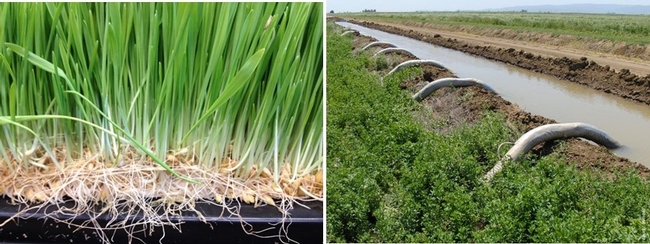During our current severe drought any technique that saves water excites us more than a dog in a sausage factory.
Thus the comments by some claiming substantial water savings by growing forage hydroponically as a livestock feed has attracted substantial interest.
Most recently in early September 2016, there was a national NPR radio broadcast about a California rancher who uses a hydroponic growth technique to sprout barley to create forage to feed to sheep. [See: ‘With Water in Short Supply, One California Farmer Grows Feed Indoors” broadcast August 2016 by Ezra David Romero (npr.org/sections/thesalt/2016/08/31/491927486/with-water-in-short-supply-california-ranchers-grow-their-feed-indoors ]
This seems like a great idea – sprout grain with just a bit of water and feed your herd a highly nutritious and highly palatable forage! But does it really save water? Let's see if we can figure this out.
Some have claimed that sprouted barley grain (left) for animal feed uses less water than a hay crop like the alfalfa (right). However, is this really the case?
First a little background: In the fall of 2013, a very nice gentleman stopped by UC Davis and met with us to discuss undertaking a nutritional analysis of sprouted barley seeds (i.e. roots, residual seeds, sprouts; but let's call them simply ‘sprouts') as an animal feed. He had developed an efficient apparatus for sprouting the seeds and harvesting the sprouts. We thought this was a cool idea, and agreed to help out.
Over the next couple of months, with student helpers, we analyzed several batches of sprouts, and then published a blog summarizing our findings. [See: ucanr.edu/blogs/blogcore/postdetail.cfm?postnum=11721 . Interestingly –we've had more activity (pro and con) on this blog than any other over the years, with over 4,000 internet hits and 223 comments.
OVERALL FINDINGS OF OUR EVALUATION IN GENERAL:
- There was a 25-30% loss in the dry weight (i.e. non-water) of the seeds versus the sprouts, and the loss of dry weight increased as the days sprouted increased.
- The sprouts had good nutritional quality, with about 15% of the dry weight as protein, and they were very low in structural fiber (which has a relatively low nutritional value to cattle and sheep). They also appeared to be quite palatable.
- Under all realistic production cost scenarios, production of the sprouts on a dry weight basis was substantially higher than the cost of feeding barley seeds directly, or the costs of purchased hay. Exact numbers depend on which costs are included (such as labor and energy) and what feeds are being compared.
- The authors were also aware from on-line videos that cattle and sheep relish the sprouts, which was no surprise. The high palatability of sprouts is similar to the behavior of cattle and sheep who relish top quality alfalfa hay or fresh chopped cereal or clover crops.
Loss of Feed Quantity is a Key Drawback. The first finding is important: production of sprouts from grains resulted in less feedable dry weight than the seeds before sprouting. The grower would have had more to feed the animals if he had fed them the seeds rather than sprouting the seeds. Germinating seeds use up carbohydrates stored in the seeds and that carbon is released as CO2. Other published work has reported similar losses in the amount of dry weight and feed energy (i.e. calories) in sprouts versus the seeds that were used to create them, due to the conversion of storage starch to soluble carbohydrates, evolution of carbon as CO2, and growth of the seedling (Pate et al., 2005; Faezeli et al., 2014; Hafla et al., 2014).
Disappointing Economics. The economic comparison that we did showed the sprouting concept did not save money. This has since been confirmed by others. Proponents of hydroponic forage estimate the cost as about $100/ton wet weight (see the original blog Putnam et al., 2013), which is similar to other estimations we've seen. In a 2014 study at Oregon State University, the farmers utilizing sprouted feed estimated costs at $103 to $110/ton wet weight although the OSU researchers estimated the costs to be $184/ton wet weight (Kerr et al., 2015). This may sound good until you adjust for the water in the feed – typically 85-90% of the weight of sprouts is water, so the ‘hay equivalent price' (i.e., 10-13% moisture feed) of $100/ton wet weight sprouts is actually about $580/ton hay equivalent price. This is very pricey compared to recent prices for alfalfa and grassy hays in California which ranged from $70 to $235/ton Hay Equivalent price, depending upon quality, type, and location (USDA-Hay Market News, Sept. 2016).
BUT WHAT ABOUT WATER USE?
An additional key issue is whether sprouts created from barley seeds, or other seeds such as corn, wheat or peas, grown hydroponically to produce animal feed can save water versus conventional field systems. The radio broadcast touted production sprouts as a ‘water conservation' technique, presumably compared to conventional field cultivation/harvest systems.
If one has a herd of cattle or sheep to feed, there are several choices available to feed those animals:
1) Produce your own hay or graze fields directly
2) Purchase hay for feeding
3) Purchase grain and feed directly (typically one grinds the grain before feeding)
4) Purchase grain and sprout the grain before feeding
5) Feed purchased supplements such as canola or soybean meal (typically combined with forage)
As cattle and sheep have a daily demand for feed, and it can be met in any of several ways, typically a farmer will use a combination of the options listed above. Number 1 is the traditional method, but if land and/or water is limiting, this may be restricted or not possible at all. Thus some purchased alternative feed acquisition systems will be needed. So are sprouts a more water-use efficient feed production/acquisition method than other options?
How much water does sprouting take? The best estimate on this issue comes from a Sandia project conducted in the early 2000's in New Mexico funded by DOE (Pate et al., 2005). They measured the water used in the sprouting process at about 1048 gallons/dry weight ton of sprouts, and wrote that they thought it could be managed to be less water than this. This was a comprehensive study that contains some good quality data as well. It was interesting that in their analysis of water, they didn't consider the water used for crop production (to produce the seeds used for sprouting), which (we shall see) is MUCH higher than the water used in the sprouting process itself.
COMPARING CROP OPTIONS IN WATER USE EFFICIENCY:
Water Used for Sprouts. When considering just the sprouts, the Water Use Efficiency (i.e., dry weight produced/unit water used in sprouting) is actually negative since there is a loss in feed quantity due to sprouting as we discussed above. Thus water is added with less than zero yield (i.e., a 25% loss in dry weight of the seeds comparing before and after sprouting). This does not include the loss in calories per pound of dry weight grain versus dry weight sprouts. To say it another way, by adding water to a 100 lb bag of barley would provide about 75 lbs. of feed available to the animal, resulting in a negative Water Use Efficiency.
Water Used for Feeds. The key issue is overall how much water the feeding system uses. We used average public data to calculate the water use, yield, and water use efficiencies of several feed options available to livestock operators (Table 1). This shows that the water used for sprouting is trivial compared with the water used to produce the crop itself, whether it's grain or hay, or even sprouted barley. Water used to produce an average California barley crop of 3,086 lbs. dry weight grain/acre is about 1.6 Acre-Feet (521,360 gallons) whereas the water used to sprout that crop would be about 1213 gallons, or 0.2% as much water as is used to grow the crop itself!
The hay crops tend to produce more dry matter (DM) yield per unit water than the grains, and were highest in water use efficiency (dry matter produced per unit water), then grains, followed by sprouted grain (Table 1).
SUMMARY
The claim that sprouted barley seeds saves water for livestock production is simply not true. Our calculations show that
- Water Use Efficiency (WUE) of Sprouting is negative. The dry weight feed yield per unit water added during sprouting process itself is less than zero – that is, there is a negative dry weight yield from sprouting in all the data we have seen on the issue, which is entirely consistent with biological principles. Most seeds used stored energy to sprout a seedling, resulting in loss of carbohydrates. Barley grain itself is far superior to sprouts in water use efficiency (WUE) due lack of losses after harvest (Table 1).
- Water Use Efficiency (WUE) of Feed Production is superior with hay or grains. Growing of any crop uses considerable water, as illustrated by the fact that we use Acre Feet to measure water in agriculture, not gallons. WUE in hay crops is almost always higher than grains because 100% of the biomass of the crop is harvested versus <50% for grain harvest only (we should note that small grain hay itself is very high in WUE, due to its winter growth habit and the fact that you harvest the whole plant). In this example, grassy or hay crops were highest in WUE, raw grains next, and sprouts last - due to the large loss in dry weight during sprouting process.
- Comparing Options. When considering total water needed for livestock, feeding sprouts is not more water-use efficient than feeding the grain directly, unless the water used to produce the grain itself is ignored, which is greater than 99% of the water requirement of growing the feed crop. Water used used during the sprouting operation is trivial.
- Local versus distant water. Proponents have a good point in that sprouting uses less LOCAL water than growing ones own forage in the field, and enables the farmer to be more self-sufficient. However, all feed crops (hay, grain) could be grown some distance away from the livestock operation, thus lessening local water demands and so exporting the water burden to other areas. This is a benefit of purchased feeds of all types (i.e., grains, hay, sprouts). It is not unique to sprouts, which use MORE water per unit feed than grain or hay.
The overall water use for crop production must be considered when evaluating the water-use efficiency of a feeding system, as well as the economics of the system, and on those criteria the sprouting concept does not hold up.
REFERENCES
Daley, C.A., C. Phillips, D. Heffner, and B. Roque. 2014 Research Report: Hydroponic Barley Fodder as a Grain Alternative in the Organic Dairy Ration. http://nebula.wsimg.com/33c0820d8f7f469962277a789cf2391e?AccessKeyId=220F6E13424FA33C937A&disposition=0&alloworigin=1
Fazaeli, H., H.A. Golmoihammadi, S.N. Tabatabayee and M. Asghari-Tabrizi. 2012. Productivity and Nutritive Value of barley Green Fodder Yield in Hydroponic System. World Applied Sciences J. 16 (4): 531-539.
Hafla, A.N., K.J. Soder, A.F. Brito, M.D. Rubano, C.J. Dell. 2014 Effect of sprouted barley grain supplementation of an herbage-based or haylage-based diet on ruminal fermentation and methane output in continuous culture.
Kerr, S., L. Conway, A. Conway. 2015. Fodder for Forage: Fact, Folly, Fable or Fabulous? Oregon State University Small Farms. Winter, 2014. Vo., IX, No. I. http://smallfarms.oregonstate.edu/sfn/w14fodder
Pate, R., P. Pohl, J. Davis, J. Campbell, L. Szumel, N. Berry, V. Gupta, E. Baynes, T. Nakaoka, C. Loest, J. Waggoner, G. Giacomelli, J. Jordan, C. Aguirre, D. Ramos, J. Ochoa, J. Aguilar. 2005. Systems Assessment of Water Savings Impact of Controlled Environment Agriculture Utilizing Wirelessly Networked SDAC systems. Sandia National Laboratories, Albuquerque, NM and Livermore, CA. SAND2005-0759. February, 2005. http://www.osti.gov/scitech/biblio/922067-vKhc9b/
Putnam, D.H., P. Robinson and E. Lin. 2013. Does Hydroponic Forage Production Make Sense? Alfalfa & Forage News Blog Oct. 11, 2013. UC Cooperative Extension. //ucanr.edu/blogs/blogcore/postdetail.cfm?postnum=11721
USDA-NASS. National Agricultural Statistics Service. Annual Crop Reports 2013-2015. https://www.nass.usda.gov/
USDA Hay Market News. Agricultural Marketing Service. September 2016: www.ams.usda.gov/mnreports/ml_gr311.txt).

